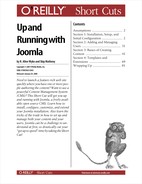Copyright © 2009 O'Reilly Media, Inc.
January 29, 2008
Abstract
Need to launch a feature-rich web site quickly where you have one or more people authoring the content? Want to use a powerful Content Management System (CMS)? This Short Cut will get you up and running with Joomla, a freely available open source CMS. Learn how to install, configure, customize, and extend your Joomla installation. Also learn the tricks of the trade in how to set up and manage both your content and your users. Joomla can be a challenge to understand at first, so drastically cut your “get up to speed” time by taking the Short Cut!
For this material to work, we have made some assumptions about your depth of knowledge. While we make every attempt to help you understand how to perform a particular task, we limit our coverage of operating systems, web servers, PHP, and databases in order to better focus on the majority of the content on Joomla (http://www.joomla.org) itself. Here are some of the assumptions we make:
You know what Joomla is—at least enough to understand that it is a CMS that is used to manage and deliver web sites.
You do not expect this material to be comprehensive. Keep in mind that it’s a Short Cut, not a comprehensive guide. While we often provide pointers to features and functionality we do not cover here in detail, it is impossible for us to mention or cover everything. If you see something you want to know more about, please check out the Joomla web site.
Once we provide the URL, you can locate the necessary files to download and install on your particular system (Windows, Linux, Mac OS X, etc.).
You have a user account with the necessary permissions to install and configure these components on your machine. While it is not required, it is preferable that you have root or administrative access.
You have command-line (direct, or via telnet or ssh) access to the machine you are performing the installation on. We also assume that you know how to remotely access the machine, if necessary, and how to use the command line.
You know how to modify filesystem permissions as needed.
You have basic networking knowledge, such as how to access machines on your network via hostname or IP address and port numbers. This also includes an understanding of terms such as localhost.
Basic understanding of web servers (Apache, IIS, etc.), databases (MySQL), and PHP, and the ability to install, configure, and run.

